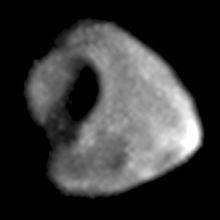Thebe (moon)
Thebe or Jupiter XIV, is the fourth of Jupiter's known moons (by distance from the planet). It was found by Stephen P. Synnott in images from the Voyager 1 space probe taken on March 5, 1979 and was given the designation S/1979 J 2.[5][6] Later, it was found on images dating back to February 27, 1979. In 1983 it was officially named after the mythological nymph Thebe who was the daughter of the river god Asopus and a lover of Zeus (the Greek equivalent of Jupiter).[7]
 | |
| Discovery | |
|---|---|
| Discovered by | Stephen P. Synnott / Voyager 1 |
| Discovery date | March 5 1979 |
| Orbital characteristics | |
| Periapsis | 218,000 km[1] |
| Apoapsis | 226,000 km[1] |
Mean orbit radius | 221889.0 ± 0.6 km (3.11 RJ)[2] |
| Eccentricity | 0.0175 ± 0.0004[2] |
| 0.674536 ± 0.000001 d (16 h 11.3 min)[2] | |
Average orbital speed | 23.923 km/s[1] |
| Inclination | 1.076 ±0.003° (to Jupiter's equator)[2] |
| Satellite of | Jupiter |
| Physical characteristics | |
| Dimensions | 116×98×84 km[3] |
Mean radius | 49.3 ± 2.0 km[3] |
| Volume | ~500,000 km³[1] |
| Mass | 4.3×1017 kg[1] |
Mean density | 0.86 g/cm³ (assumed) |
| ~0.020 m/s² (0.004 g)[1] | |
| ~0.040 km/s[1] | |
| synchronous | |
| zero | |
| Albedo | 0.047 ± 0.003[4] |
| Temperature | ~124 K |
Orbit
changeThebe is the farthest of the inner Jovian moons. It orbits Jupiter at a distance of ~222,000 km (3.11 Jupiter radii). The orbit of Thebe has an orbital eccentricity of ~0.018 and an inclination of ~1.08° relative to the equator of Jupiter.[2] These values are unusually high for a closer moon and can be explained by the past influence of the closest Galilean satellite Io; in the past, several mean motion resonances with Io would have passed through Thebe's orbit as Io gradually moved away from Jupiter, and these excited Thebe's orbit.[8]
Physical characteristics
changeThebe is not a sphere, with the closest ellipsoidal approximation being 116x98x84 km. Its bulk density and mass are not known but assuming that it mean density is like that of Amalthea (~0.86 g/cm³)[3] its mass can be estimated at ~4.3×1017 kg.
The surface of Thebe is dark and appears to be reddish in color.[4]
Exploration
changeThebe was found in Voyager 1 images by Steve Synnott, a member of the Voyager navigation team.[6] However, before the Galileo spacecraft arrived at Jupiter, little was known about it. Galileo imaged almost all of the surface of Thebe and put constraints on its composition.[3]
References
change- ↑ 1.0 1.1 1.2 1.3 1.4 1.5 1.6 Calculated on the basis of other parameters
- ↑ 2.0 2.1 2.2 2.3 2.4 Cooper, N.; Murray, C.; Porco, C.; Spitale, J. (2006). "Cassini ISS astrometric observations of the inner jovian satellites, Amalthea and Thebe". ICARUS. 181 (1): 223–234. Bibcode:2006Icar..181..223C. doi:10.1016/j.icarus.2005.11.007.
- ↑ 3.0 3.1 3.2 3.3 Thomas, P.C.; Burns, J.A.; Rossier, L.; Simonelli, D.; Veverka, J.; Chapman, C.R.; Klaasen, K.; Johnson, T.V.; Belton, M.J.S. (1998). "The Small Inner Satellites of Jupiter". ICARUS. 135 (1): 360–371. Bibcode:1998Icar..135..360T. doi:10.1006/icar.1998.5976.
- ↑ 4.0 4.1 Simonelli, D. (2000). "Leading/Trailing Albedo Asymmetries of Thebe, Amalthea, and Metis". ICARUS. 147 (2): 353–365. Bibcode:2000Icar..147..353S. doi:10.1006/icar.2000.6474.
- ↑ IAUC 3470: Satellites of Jupiter 1980 April 28 (discovery)
- ↑ 6.0 6.1 Synnott, S.P. (1980). "1979J2: The Discovery of a Previously Unknown Jovian Satellite". Science. 210 (4471): 786–788. Bibcode:1980Sci...210..786S. doi:10.1126/science.210.4471.786. PMID 17739548.
- ↑ IAUC 3872: Satellites of Jupiter and Saturn 1983 September 30 (naming the moon)
- ↑ Burns, J.A.; Simonelli, D.P. & Showalter, M.R. et al. (2004), "Jupiter’s Ring-Moon System", in Bagenal, F.; Dowling, T. E.; McKinnon, W. B., Jupiter: The planet, Satellites and Magnetosphere, Cambridge University Press
Other websites
change- Thebe Profile Archived 2007-06-08 at the Wayback Machine by NASA's Solar System Exploration